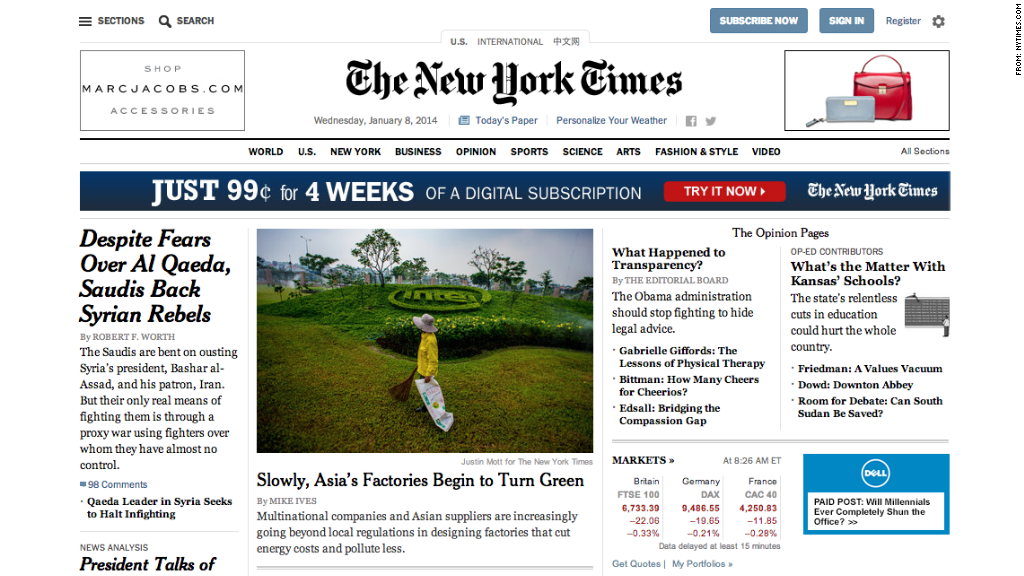
The last time The New York Times embarked on a wholesale redesign of its Web site, in 2006, the iPhone wasn't on the market. Tablets like the iPad were still years away.
So the new design that The Times is unveiling Wednesday is generating much interest within the journalism industry, both for what it says about The Times and about the future of online publishing.
For visitors to NYTimes.com, it will be obvious "that we've redesigned our article pages and restyled our homepage and section fronts to provide a cleaner, more engaging user experience," said Denise Warren, the executive vice president of the digital products and services group at The Times.
What won't be obvious is this: behind the curtain, there is a whole new publishing and technology system. "This allows us to continually iterate on the site and take advantage of new technology trends as they happen, so instead of seeing major redesigns in the future, users will see more incremental changes over time," Warren said.
While the refreshed home page and article pages retain some of the feel of the print newspaper, the redesign highlights the fact that, as the well-respected news media analyst Ken Doctor put it, "digital publishing is getting to be the main publishing system of the Times, with print becoming a niche, if still a very big one."
Redesigns of Web sites as massive as NYTimes.com are fraught with complexity, not to mention the possibility that readers will be turned off by the changes. The Times, the flagship brand of The New York Times Company (NYT), has been testing the new design internally for some time and adjusting it along the way.
A disclosure is important here: I was a media reporter at The Times for six years. While there, I occasionally engaged in a time-honored reporter ritual -- complaining -- in this case about the limitations of The Times' online publishing tools. But I also gained respect for the people in charge of those tools. I departed The Times in November 2013, and for this story, I refrained from speaking with any former colleagues about the redesign outside of formal interviews.
Many outside The Times see it as a Cadillac of print and online publishing — so it's not surprising that the redesign has already generated press attention. Fast Company magazine said this week that the newspaper has "eight years of catching up to do."
The new site is designed with mobile readership in mind, now that roughly a third of its traffic comes from users on smart phones and tablets. "It was important that we created a responsive layout that enhances the presentation of our content on larger desktops down to tablets," Warren said.
Doctor said that "the flip side is that two-thirds of all the traffic still comes from desktops and laptops. So while the mobile news revolution is hugely important, the Web still brings most of the digital readers and most of the digital advertising."
The new system also allows for new kinds of advertising, which is critical for The Times because digital advertising revenues have been trending downward. In the third quarter of last year, the revenues were down 3.4% versus the same quarter the prior year.
Most notably, the redesign introduces fast-growing "native advertising" to NYTimes.com. The Times is calling these ads Paid Posts. They resemble articles written by reporters — thus they are "native" — but they are actually written by sponsors. Dell is the first purchaser of Paid Posts, and on Wednesday, there were several such posts on the Web site.
The Times publisher Arthur Sulzberger, Jr. acknowledged in a memorandum last month that ads that appear to be articles "can be controversial" among journalists, but said he expected that "native advertising will play a part in helping restore digital advertising revenue to growth -- something we need to do to support our investment in the journalism of The New York Times."
The Paid Posts are surrounded by a blue border to distinguish them from regular articles; are prefaced with a disclaimer that they are "paid for and posted by" outside companies; and are formatted in a different font.
There are other kinds of new ads on NYTimes.com too, including something called a "Ribbon unit" that will show up within the new top-of-the-page navigation bar. (Dell's Paid Posts appeared there on Wednesday.)
"The design also creates more white space, which makes advertising units more prominent now than they have been in the past," Warren said.
Even as it tries to improve its digital advertising picture, The Times is increasingly dependent on subscribers for revenue; at last count it had upwards of 700,000 digital subscribers. The company's hope is that a richer Web site will keep those subscribers happy and woo new ones.
"The more readers engage -- finding an intriguing movie profile when they came to the site to follow the latest news from Afghanistan -- the more likely they are to renew their subscriptions and accept annual price increases," Doctor said.
He also noted that one "small but noticeable change" will be faster-loading Web pages on NYTimes.com. "Of course, the more of them, the more page views and that reinforcement of engagement," he said.

